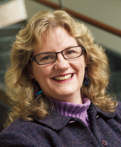Article co-authored by Strandburg is centerpiece of Cornell Law Review issue
 “Constructing Commons in the Cultural Environment,” an article co-authored by Professor Katherine Strandburg, is the centerpiece of the May 2010 issue of the Cornell Law Review. At the journal's suggestion, the issue consists entirely of Strandburg’s co-authored article, six responding articles from commentators, and the co-authors’ reply to those responses.
“Constructing Commons in the Cultural Environment,” an article co-authored by Professor Katherine Strandburg, is the centerpiece of the May 2010 issue of the Cornell Law Review. At the journal's suggestion, the issue consists entirely of Strandburg’s co-authored article, six responding articles from commentators, and the co-authors’ reply to those responses.
The article, co-written by Strandburg, Professor Brett Frischmann of Loyola University Chicago School of Law, and Professor Michael Madison of the University of Pittsburgh School of Law, proposes a framework for evaluating “cultural commons” arrangements. In a parallel to the “natural commons” research of Nobel Prize-winning political scientist Elinor Ostrom regarding shared physical resources, Strandburg and her co-authors suggest a set of questions to apply to the scrutiny of different collaborative intellectual property scenarios. Ostrom herself is one of the commentators on the new Cornell Law Review article.
“Until recently, intellectual property scholarship has been pretty focused on a very individualistic and economic incentive approach,” Strandburg said. “I don’t have any problem with that approach, but we’re starting to realize there are many situations in which creativity of various kinds is occurring in something other than this individualized market-oriented paradigm.”
Strandburg, who was a research physicist at Argonne National Laboratory before beginning her legal career, had long contemplated the difference between the collaborative nature of scientific research and the more individualistic focus of intellectual property law. “It was immediately striking to me when I first started thinking about IP that collaboration is really peripheral to the way IP is set up. So I’ve been thinking about that in the context of scientific research and research communities, and how social norms affect the way that people interact in those communities. We’re just starting to see how more people are thinking about these questions—how you get creativity in an institutional setting.”
A prime example of this, she said, is the open-source software model—one of the most studied cultural commons models—in which numerous people with different levels of involvement create an intangible product: “The non-rivalrous nature of cultural goods allows the nested levels of participation in a cultural commons to be different and more complex than is usual for a natural resource commons.” Such arrangements give rise to questions about who gets credit and what sorts of creative rights contributors should have.
While some case studies for different cultural commons arrangements do exist—on subjects as diverse as the recipes of French chefs, fashion designs, and comedians’ jokes—there have not been many detailed ones, Strandburg said, and the ones that have been done do not always answer the same set of questions. Her article seeks to establish a systematized approach to evaluating these arrangements, which will invariably differ according to the unique needs of the creative communities in which they originate.
In connection with the Engelberg Center on Innovation Law and Policy, Strandburg will host a conference on cultural commons in September 2011 at the NYU School of Law. Ostrom will be among the speakers.
“What to me would be the best outcome is if all the various people who are interested in doing these case studies…start to think about how we can systematize this, rather than just, ‘I’ll do my case study and you do your case study,’” Strandburg said. “We hope that our article will be a start, and then people can respond and perhaps even disagree, but hopefully it will move the ball…to a point where there’s more conversation among different people who are studying these commons arrangements.”
Posted on May 25, 2010